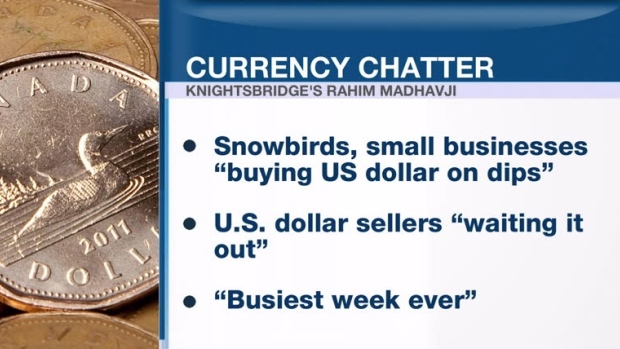Jul 11, 2017
Loonie falls ahead of rate decision as markets brace for possible 'buy the rumour, sell the fact'
By Noah Zivitz
The Canadian dollar is taking a breather on the eve of what’s expected to be the Bank of Canada’s first rate increase since September 2010.
The loonie has closed down in three of the last four trading sessions, finishing Tuesday's trade at 77.38 cents US. The dollar had climbed to 77.75 cents US last week, the highest level since Sept. 8.
“There could be a risk of a classic ‘buy the rumour, sell the fact’ post-BoC-meeting selling,” warned Gluskin Sheff + Associates Chief Economist David Rosenberg in a report to clients Monday.
“While one rate hike is pretty well baked into the cake, two moves are not, and it would make little sense for the BoC to just remove one of the dual ‘emergency’ cuts engineered back in the first half of 2015.”

- 'Major quibble' as the Bank of Canada gears up to raise rates
- Boosting rates can curb the 'debt appetite' of Canadians: CIBC
- 'Misguided' for Bank of Canada to raise rates: Capital Economics
BANK OF CANADA: WILL THEY OR WON'T THEY?
The primary catalyst for the dollar has been the Bank of Canada’s abrupt swing to a hawkish tone, starting with Senior Deputy Governor Carolyn Wilkins’ speech in Winnipeg on June 12. “As growth continues and, ideally, broadens further, Governing Council will be assessing whether all of the considerable monetary policy stimulus presently in place is still required,” she warned in the speech.
Back then, the implied probability of the bank raising rates at its next meeting was just 13.4 per cent. As of Tuesday morning, the probability of rates rising 25 basis points on Wednesday was 92.2 per cent.
“The market, I think, was caught off guard by the Bank of Canada changing tone,” said BMO Global Asset Management Chief Investment Officer of Asset Allocation Paul Taylor in an interview with BNN Tuesday. “Now I think it’s all about – obviously, firstly – do they go? And then it’s all about the language and the signalling as we go forward.”


